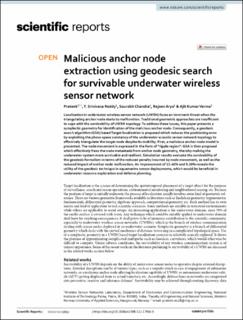| dc.contributor.author | Prateek, NN | |
| dc.contributor.author | Reddy, T. Srinivasa | |
| dc.contributor.author | Chandra, Saurabh | |
| dc.contributor.author | Arya, Rajeev | |
| dc.contributor.author | Verma, Ajit Kumar | |
| dc.date.accessioned | 2023-03-23T10:05:19Z | |
| dc.date.available | 2023-03-23T10:05:19Z | |
| dc.date.created | 2022-10-19T12:15:02Z | |
| dc.date.issued | 2022 | |
| dc.identifier.citation | Scientific Reports. 2022, 12 (1), . | en_US |
| dc.identifier.issn | 2045-2322 | |
| dc.identifier.uri | https://hdl.handle.net/11250/3060069 | |
| dc.description.abstract | Localization in underwater wireless sensor network (UWSN) faces an imminent threat when the triangulating anchor node starts to malfunction. Traditional geometric approaches are insufficient to cope with the survivability of UWSN topology. To address these issues, this paper presents a symplectic geometry for identification of the malicious anchor node. Consequently, a geodesic search algorithm (GSA) based Target localization is proposed which reduces the positioning error by exploiting the phase-space constancy of the underwater acoustic sensor network topology to effectively triangulate the target node despite its mobility. First, a malicious anchor node model is presented. The node movement is expressed in the form of “ripple region”. GSA is then proposed which effectively frees the node metastasis from anchor node geometry, thereby making the underwater system more survivable and resilient. Simulation results evaluate the survivability of the geodesic formalism in terms of the reduced penalty incurred by node movement, as well as the reduced impact of anchor node malfunction. An improvement of 13.46% and 9.26% reveals the utility of the geodesic technique in aquamarine sensor deployments, which would be beneficial in underwater resource exploration and defense planning. | en_US |
| dc.language.iso | eng | en_US |
| dc.publisher | Nature Research | en_US |
| dc.rights | Navngivelse 4.0 Internasjonal | * |
| dc.rights.uri | http://creativecommons.org/licenses/by/4.0/deed.no | * |
| dc.title | Malicious anchor node extraction using geodesic search for survivable underwater wireless sensor network | en_US |
| dc.type | Peer reviewed | en_US |
| dc.type | Journal article | en_US |
| dc.description.version | publishedVersion | en_US |
| dc.rights.holder | © The Author(s) 2022 | en_US |
| dc.source.pagenumber | 0 | en_US |
| dc.source.volume | 12 | en_US |
| dc.source.journal | Scientific Reports | en_US |
| dc.source.issue | 1 | en_US |
| dc.identifier.doi | 10.1038/s41598-022-17956-9 | |
| dc.identifier.cristin | 2062745 | |
| dc.source.articlenumber | 13691 | en_US |
| cristin.ispublished | true | |
| cristin.fulltext | original | |
| cristin.qualitycode | 1 | |

